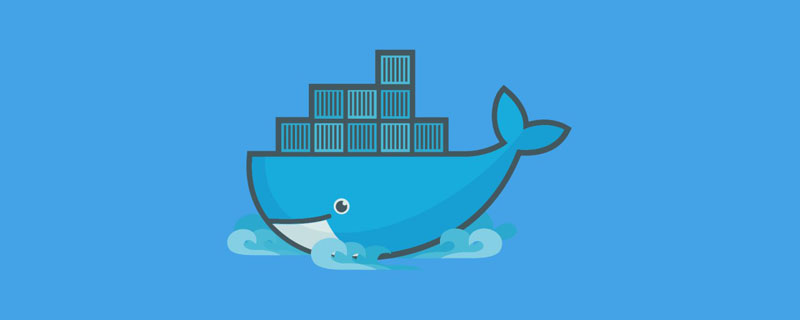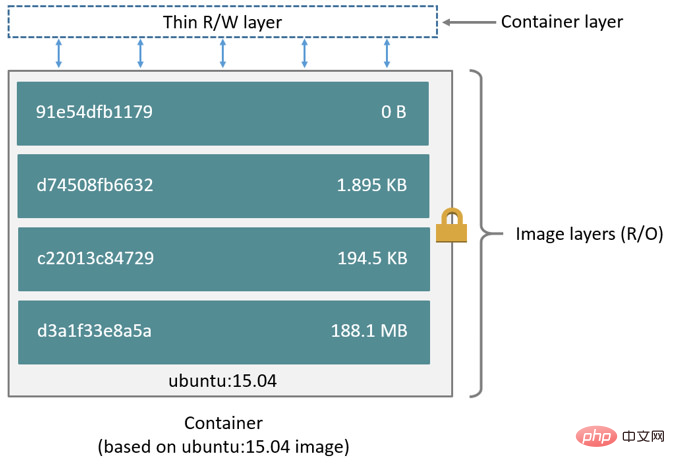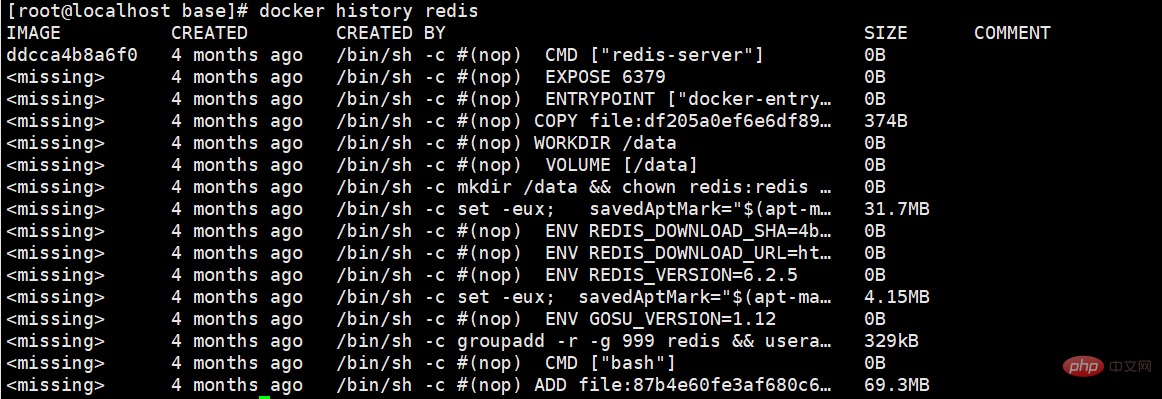 Operation and Maintenance
Operation and Maintenance
 Docker
Docker
 You can learn the idea of layered reuse with Docker in ten minutes
You can learn the idea of layered reuse with Docker in ten minutes
You can learn the idea of layered reuse with Docker in ten minutes
This article brings you issues related to image layering, container layering and the disk space occupied by containers in Docker. I hope it will be helpful to you.

How Docker organizes storage
Dokcer cleverly applies the idea of hierarchical reuse when organizing storage content. So we can use this as a case to learn this idea.
1. Image layering
A Docker image is divided into many layers during the construction process, and each layer is read-only. Let’s illustrate with the following example:
# syntax=docker/dockerfile:1 FROM ubuntu:18.04 LABEL org.opencontainers.image.authors="org@example.com" COPY . /app RUN make /app RUN rm -r $HOME/.cache CMD python /app/app.py
There will be 4 instructions in this Dockerfile that change the file system and create a new layer. The
-
FROMcommand creates the base layer from the ubuntu:18.04 image. -
LABELThe command only modifies the metadata of the image and does not create a new layer. The -
COPYcommand adds the contents of the current directory where this build is executed to the image, and creates a new layer to record the changes. - The first
RUNinstruction builds the program and outputs the results to the image, creating a new layer to record the changes. - The second
RUNcommand deletes the cache directory and creates a new layer to record the changes. The -
CMDdirective defines the instructions to be run in the container. It only modifies the metadata of the image and does not create a new layer.
Here each layer only records the differences from the previous layer. When we create a container, a writable layer is created, also called the container layer. Changes to the contents of running containers are recorded in this layer. The following figure describes this relationship:

2. Container layering
The main difference between containers and images is the top-level The write layer is different. All write operations to the container will be recorded in this layer. If the container is deleted, the writable layer will also be deleted, but the image will be retained.
Note: If you want multiple containers to share the same data, you can use Docker Volumes.
Each container has its own writable layer, where all transformations will be stored, so multiple containers can share the same image. The following figure describes this relationship:

Note: There is another detail here. Multiple mirrors may share the same layer, such as two mirrors. If the same layer is found locally when building or pulling, it will not be built or pulled again. Therefore, when calculating the image size, you cannot just sum up the size displayed by the docker images command. The value may be greater than the actual value.
3. The space occupied by the container on the disk
You can use the docker ps -s command to see the space occupied by the running container. (partial value). The different contents represented by the two columns:
- size: The disk size occupied by the container’s writable layer
- virtual size: Includes the size of the container’s writable layer and read-only image .
Other ways in which containers occupy disk space:
- Log files generated by containers.
- Contents mounted using Volume and bind mounts.
- Container configuration file
- Contents in memory (if swapping is enabled)
- Checkpoints (if this function is used)
4.Copy-on-Write (CoW) strategy
The storage drivers in Docker all use this strategy.
CoW strategy can share and copy files with maximum efficiency. If a file exists in a lower layer of the image, then its upper layer (including the writable layer) needs to read the content and can use the file directly. When it needs to be modified, the file is copied to this layer and modified. This minimizes IO and the size of each subsequent layer.
4.1 Sharing makes the image smaller
When we use docker pull to pull the image or use an image that is not available locally to create a container , the image will be hierarchically stored in the local Dockers storage area. In Linux it is usually /var/lib/docker.
We can go to the /var/lib/docker/<storage-driver></storage-driver> directory to see that we have pulled the images of each layer. For example, use overlay2 storage driver.

With so many layers, we can use docker image inspect to see which layers a certain image contains
docker image inspect --format "{{json .RootFS.Layers}}" redis
docker image inspect --format "{{json .RootFS.Layers}}" mysql:5.7

Through the above review, we can see that redis and mysql5.7 use the same layer. Sharing the same layer greatly saves the storage image space and also improves the pull. The speed of mirroring.
我们可以通过 docker image history命令来查看镜像分层情况,以redis为例
docker history redis

注意 :
有些步骤的大小为0,是因为他们只改变了元数据,并不会产生新层,也不会占用额外的空间(除元数据本身)。所以上述redis镜像中包含了5层。
-
<missing></missing>步骤,这些步骤可能是以下情况中的一种- 在另一个系统上构建的
- 从Docker Hub中提取的
- 使用BuildKit作为构建器构建的。
4.2复制让容器更有效率
当我们启动一个容器的时候,会添加一个可写层在镜像之上,用于存储所有的变化。当对已有文件进行修改的时候采用CoW策略。首先会到各层寻找到该文件,然后复制该文件到可写层,然后进行修改并存储。
这么做能够让我们最大限度地减少I/O操作。
但是,很明显的是当一个容器中的应用需要进行频繁的写操作,那么会造成可写层越来越庞大,此时我们可以通过Volume来帮助我们分担压力。
容器的元数据和日志是单独存放的,一般是存放在 /var/lib/docker/containers中,我们可以使用 du -sh /var/lib/docker/containers/*来查看各个容器占用多少。(容器ID其实就是文件夹名称的前12位)。

推荐学习:《docker视频教程》
The above is the detailed content of You can learn the idea of layered reuse with Docker in ten minutes. For more information, please follow other related articles on the PHP Chinese website!

Hot AI Tools

Undresser.AI Undress
AI-powered app for creating realistic nude photos

AI Clothes Remover
Online AI tool for removing clothes from photos.

Undress AI Tool
Undress images for free

Clothoff.io
AI clothes remover

Video Face Swap
Swap faces in any video effortlessly with our completely free AI face swap tool!

Hot Article

Hot Tools

Notepad++7.3.1
Easy-to-use and free code editor

SublimeText3 Chinese version
Chinese version, very easy to use

Zend Studio 13.0.1
Powerful PHP integrated development environment

Dreamweaver CS6
Visual web development tools

SublimeText3 Mac version
God-level code editing software (SublimeText3)

Hot Topics
 How to exit the container by docker
Apr 15, 2025 pm 12:15 PM
How to exit the container by docker
Apr 15, 2025 pm 12:15 PM
Four ways to exit Docker container: Use Ctrl D in the container terminal Enter exit command in the container terminal Use docker stop <container_name> Command Use docker kill <container_name> command in the host terminal (force exit)
 How to check the name of the docker container
Apr 15, 2025 pm 12:21 PM
How to check the name of the docker container
Apr 15, 2025 pm 12:21 PM
You can query the Docker container name by following the steps: List all containers (docker ps). Filter the container list (using the grep command). Gets the container name (located in the "NAMES" column).
 How to start mysql by docker
Apr 15, 2025 pm 12:09 PM
How to start mysql by docker
Apr 15, 2025 pm 12:09 PM
The process of starting MySQL in Docker consists of the following steps: Pull the MySQL image to create and start the container, set the root user password, and map the port verification connection Create the database and the user grants all permissions to the database
 How to copy files in docker to outside
Apr 15, 2025 pm 12:12 PM
How to copy files in docker to outside
Apr 15, 2025 pm 12:12 PM
Methods for copying files to external hosts in Docker: Use the docker cp command: Execute docker cp [Options] <Container Path> <Host Path>. Using data volumes: Create a directory on the host, and use the -v parameter to mount the directory into the container when creating the container to achieve bidirectional file synchronization.
 How to restart docker
Apr 15, 2025 pm 12:06 PM
How to restart docker
Apr 15, 2025 pm 12:06 PM
How to restart the Docker container: get the container ID (docker ps); stop the container (docker stop <container_id>); start the container (docker start <container_id>); verify that the restart is successful (docker ps). Other methods: Docker Compose (docker-compose restart) or Docker API (see Docker documentation).
 How to update the image of docker
Apr 15, 2025 pm 12:03 PM
How to update the image of docker
Apr 15, 2025 pm 12:03 PM
The steps to update a Docker image are as follows: Pull the latest image tag New image Delete the old image for a specific tag (optional) Restart the container (if needed)
 How to view the docker process
Apr 15, 2025 am 11:48 AM
How to view the docker process
Apr 15, 2025 am 11:48 AM
Docker process viewing method: 1. Docker CLI command: docker ps; 2. Systemd CLI command: systemctl status docker; 3. Docker Compose CLI command: docker-compose ps; 4. Process Explorer (Windows); 5. /proc directory (Linux).
 How to change the docker image source in China
Apr 15, 2025 am 11:30 AM
How to change the docker image source in China
Apr 15, 2025 am 11:30 AM
You can switch to the domestic mirror source. The steps are as follows: 1. Edit the configuration file /etc/docker/daemon.json and add the mirror source address; 2. After saving and exiting, restart the Docker service sudo systemctl restart docker to improve the image download speed and stability.





